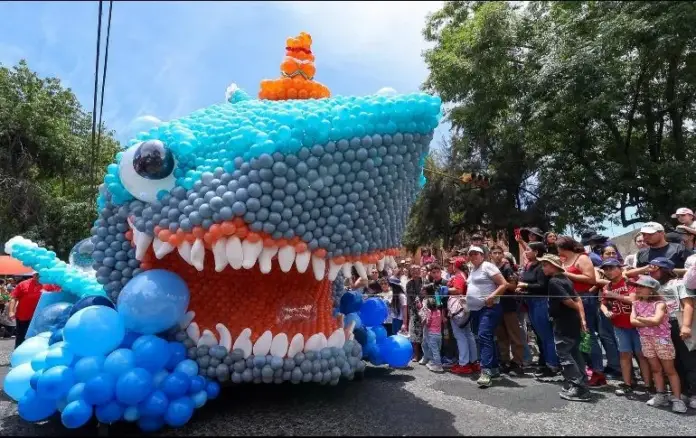The Balloon Parade, the world’s largest latex balloon parade, kicked off at noon this Sunday through the hot streets of Guadalajara, leaving behind a “sea” of celebration and color for the hundreds of Guadalajara residents who attended the event, which took place near Expo Guadalajara.
With the theme of “marine life,” a dozen enormous floats demonstrated the artistic possibilities that can be achieved with hundreds and hundreds of balloons. Guadalajara residents were able to enjoy whales, sea turtles and dolphins, giant sharks and octopuses, coral formations, and even models who, like beauty queens, paraded in balloon dresses, amid music, drums, and trumpets that gave the event a carnival-like feel.
“What the artists did with the balloons was amazing,” said Silvia, 42, who brought her two children to the parade to enjoy the experience. “I think it’s really nice that they bring this type of event for families here to Guadalajara.” She, like hundreds of others, arrived early to the meeting point. Avenida de Las Rosas was a parade of curious onlookers waiting in folding chairs, with hats and umbrellas to protect themselves from the sun; some enthusiasts even hung between tree branches, and everyone present seemed oblivious to the traffic chaos that disrupted López Mateos and nearby avenues due to the road closures.
The parade, however, justified the urban mishaps and shed light on an area of Guadalajara where these types of events are not common. Such was the case for Elvira, 57, who lives near Las Rosas, and all she needed was to open her front door to see a huge whale made of balloons of all shapes and colors, sailing amidst the din of shouts and drums beneath the trees on the street. “I really thought it was beautiful,” the interviewee mentioned. “Everything they did with the balloons looks really nice.”
Departing from Expo Guadalajara, the enormous marine animals, as if swimming in the air, elicited screams, applause, hundreds of photos, and a happy mess on their colorful journey to the Chapalita Roundabout, where the carnival atmosphere was even stronger, amidst the curiosity of Sunday passersby. People pointed out the shark’s pointed teeth, the octopus’s spiral tentacles, the deep-sea fish’s dangling light, the sadness in the sea turtle’s eyes, all achieved with hundreds and hundreds of balloons in all their shapes and possibilities.
The sheer skill of the pieces finally convinced Diego, 38, who brought his daughter to the massive event. For him, the parade wasn’t by far the largest in the world, but the marine figures justified everything else. “The people who put this all together were truly talented,” he commented. “I mean, I didn’t think the parade was anything grand, but I don’t think it’s easy to put these pieces together; they’re very beautiful.” Her daughter, however, was fascinated by the enormous crab and the pirate skull, which were the last floats in the marine procession.
The floats were built by balloon artists of various nationalities: Russia, Italy, Hong Kong, Taiwan, Singapore, Spain, Brazil, and of course, Mexico. Each float was approximately four meters high, six meters long, and took almost four days to build; they were made by teams of fifteen to twenty people using balloons as raw material.
The idea for this parade was born from the 75th anniversary celebration of Globos Payaso, a leading Jalisco company. Working in partnership with the Balloon Parade, they brought this colorful celebration to Guadalajara as a way to showcase how much can be done with latex balloons, as they are also a path to expressiveness and art. The marine animals continued their journey back to Expo Guadalajara, leaving in their wake the same trail of color, music, drums, and trumpets that never stopped for a single moment, followed by happy attendees, the screams of children, and curious onlookers who couldn’t understand why there were whales and giant octopuses at noon on a Sunday in Guadalajara. For two hours, the city witnessed an ocean in broad daylight.

Source: informador




